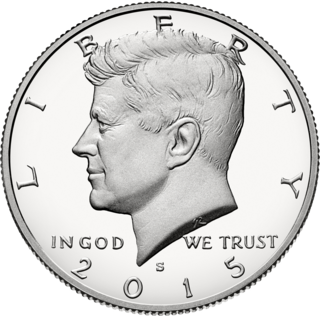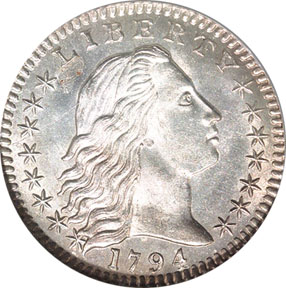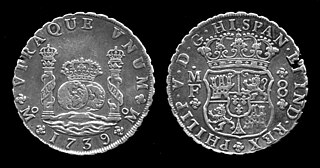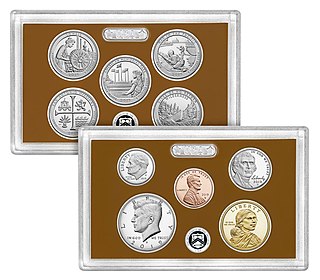United States | |
| Value | $1 |
|---|---|
| Years of minting | 2015 |
| Obverse | |
| Reverse | |
The March of Dimes silver dollar is a commemorative coin issued by the United States Mint in 2015. [1]
United States | |
| Value | $1 |
|---|---|
| Years of minting | 2015 |
| Obverse | |
| Reverse | |
The March of Dimes silver dollar is a commemorative coin issued by the United States Mint in 2015. [1]
Coins of the United States dollar were first minted in 1792. New coins have been produced annually and they make up a valuable aspect of the United States currency system. Today, circulating coins exist in denominations of 1¢, 5¢, 10¢, 25¢, 50¢, and $1.00. Also minted are bullion and commemorative coins. All of these are produced by the United States Mint. The coins are then sold to Federal Reserve Banks which in turn are responsible for putting coins into circulation and withdrawing them as demanded by the country's economy.

The United States Mint is a bureau of the Department of the Treasury responsible for producing coinage for the United States to conduct its trade and commerce, as well as controlling the movement of bullion. It does not produce paper money; that responsibility belongs to the Bureau of Engraving and Printing. The first United States Mint was created in Philadelphia in 1792, and soon joined by other centers, whose coins were identified by their own mint marks. There are currently four active coin-producing mints: Philadelphia, Denver, San Francisco, and West Point.

The dime, in United States usage, is a ten-cent coin, one tenth of a United States dollar, labeled formally as "one dime". The denomination was first authorized by the Coinage Act of 1792. The dime is the smallest in diameter and is the thinnest of all U.S. coins currently minted for circulation, being 0.705 inches in diameter and 0.053 in (1.35 mm) in thickness. The obverse of the current dime depicts the profile of President Franklin D. Roosevelt and the reverse boasts an olive branch, a torch, and an oak branch, from left to right respectively. As of 2011, the dime coin cost 5.65 cents to produce.

The half dollar, sometimes referred to as the half for short or 50-cent piece, is a United States coin worth 50 cents, or one half of a dollar. It is the largest United States circulating coin currently produced in both size and weight, being 1.205 inches in diameter and 0.085 in (2.16 mm) in thickness, and is twice the weight of the quarter. The coin's design has undergone a number of changes throughout its history. Since 1964, the half dollar depicts the profile of President John F. Kennedy on the obverse and the Seal of the President of the United States on the reverse.

The eagle was a United States $10 gold coin issued by the United States Mint from 1792 to 1933.

The half dime, or half disme, was a silver coin, valued at five cents, formerly minted in the United States.

The American twenty-cent piece is a coin struck from 1875 to 1878, but only for collectors in the final two years. Proposed by Nevada Senator John P. Jones, it proved a failure due to confusion with the quarter, to which it was close in both size and value.
The Seated Liberty portrait designs appeared on most regular-issue silver United States coinage from 1836 through 1891. The denominations which featured the Goddess of Liberty in a Seated Liberty design included the half dime, the dime, the quarter, the half dollar, and until 1873 the silver dollar. Another coin that appeared exclusively in the Seated Liberty design was the twenty cent piece. This coin was produced from 1875 to 1878, and was discontinued because it looked very similar to the quarter. Seated Liberty coinage was minted at the main United States Mint in Philadelphia, as well as the branch mints in New Orleans, San Francisco, and Carson City.

The Walking Liberty half dollar is a silver 50-cent piece or half dollar coin that was issued by the United States Mint from 1916 to 1947; it was designed by Adolph A. Weinman, a well-known sculptor and engraver.

The Kennedy half dollar, first minted in 1964, is a fifty-cent coin currently issued by the United States Mint. Intended as a memorial to the assassinated 35th president of the United States John F. Kennedy, it was authorized by Congress just over a month after his death. Use of existing works by Mint sculptors Gilroy Roberts and Frank Gasparro allowed dies to be prepared quickly, and striking of the new coins began in January 1964.

The West Point Mint is a U.S. Mint production and depository facility erected in 1937 near the U.S. Military Academy in West Point, New York, United States. As of 2019 the mint holds 22% of the United States' gold reserves, or approximately 54 million ounces. The mint at West Point is second only to the gold reserves held in secure storage at Fort Knox. Originally, the West Point Mint was called the West Point Bullion Depository. At one point it had the highest concentration of silver of any U.S. mint facility, and for 12 years produced circulating Lincoln cents. It has since minted mostly commemorative coins and stored gold.

The Barber coinage consists of a dime, quarter, and half dollar designed by United States Bureau of the Mint Chief Engraver Charles E. Barber. They were minted between 1892 and 1916, though no half dollars were struck in the final year of the series.

"Draped Bust" was the name given to a design of United States coins. It appeared on much of the regular-issue copper and silver United States coinage, 1796–1807. It was designed by engraver Robert Scot.

The Coinage Act of 1965, Pub.L. 89–81, 79 Stat. 254, enacted July 23, 1965, eliminated silver from the circulating United States dime and quarter dollar coins. It also reduced the silver content of the half dollar from 90 percent to 40 percent; silver in the half dollar was subsequently eliminated by a 1970 law.

The United States dollar is the official currency of the United States and its territories. The Coinage Act of 1792 introduced the U.S. dollar at par with the Spanish silver dollar, divided it into 100 cents, and authorized the minting of coins denominated in dollars and cents. U.S. banknotes are issued in the form of Federal Reserve Notes, popularly called greenbacks due to their historically predominantly green color.

The numismatic history of the United States began with Colonial coins such as the pine tree shilling and paper money; most notably the foreign but widely accepted Spanish piece of eight, ultimately descended from the Joachimsthaler and the direct ancestor of the U.S. Dollar.
Flowing Hair coinage was issued in the United States between 1793 and 1795. The design was used for the first half dime, half dollar, dollar, and the first two large cents.

The Roosevelt dime is the current dime, or ten-cent piece, of the United States. Struck by the United States Mint continuously since 1946, it displays President Franklin D. Roosevelt on the obverse and was authorized soon after his death in 1945.

The Coinage Act of 1853, 10 Stat. 160, was a piece of legislation passed by the United States Congress which lowered the silver content of the silver half dime, dime, quarter dollar, and half dollar, and authorized a three dollar gold piece. Although intending to stabilize the country's silver shortage, it, in effect, pushed the United States closer to abandoning bimetallism entirely and adopting the gold standard.

The United States Mint Proof Set, commonly known as the Proof Set in the United States, is a set of proof coins sold by the United States Mint. The proof set is popular with coin collectors as it is an affordable way to collect examples of United States coinage in proof condition.